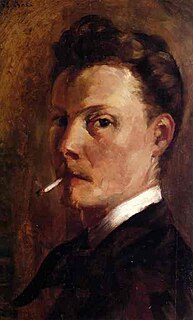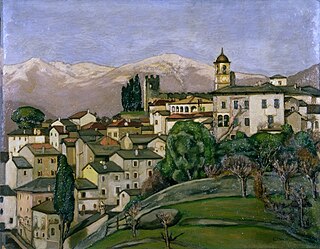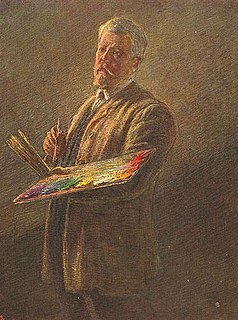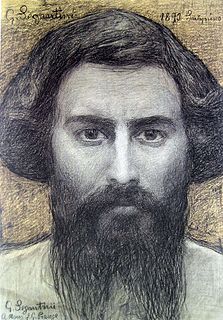 W
WUmberto Boccioni was an influential Italian painter and sculptor. He helped shape the revolutionary aesthetic of the Futurism movement as one of its principal figures. Despite his short life, his approach to the dynamism of form and the deconstruction of solid mass guided artists long after his death. His works are held by many public art museums, and in 1988 the Metropolitan Museum of Art in New York City organized a major retrospective of 100 pieces.
 W
WCarlo Cressini (1864–1938) was an Italian painter.
 W
WHenri-Edmond Cross, born Henri-Edmond-Joseph Delacroix, was a French painter and printmaker. He is most acclaimed as a master of Neo-Impressionism and he played an important role in shaping the second phase of that movement. He was a significant influence on Henri Matisse and many other artists. His work was instrumental in the development of Fauvism.
 W
WRobert Delaunay was a French artist who, with his wife Sonia Delaunay and others, co-founded the Orphism art movement, noted for its use of strong colours and geometric shapes. His later works were more abstract. His key influence related to bold use of colour and a clear love of experimentation with both depth and tone.
 W
WAntonio Discovolo (1874–1956) was an Italian painter.
 W
WDivisionism was the characteristic style in Neo-Impressionist painting defined by the separation of colors into individual dots or patches which interacted optically.
 W
WVittore Grubicy de Dragon was an Italian painter, art critic and art gallery owner who was largely responsible for introducing into Italian painting the optical theories of Divisionism. His writings and paintings influenced a generation of late 19th-century Italian painters. In addition, the Grubicy Gallery became one of the first art enterprises to be run on the concept of exhibiting living artists that were represented as clients of the gallery.
 W
WLeonardo Dudreville was a Venetian-born Italian painter. He was one of the founders of the Nuove tendenze as well as of Novecento Italian art movements.
 W
WEnrico Lione, the name chosen by Enrico Della Leonessa (1865–1921) was an Italian painter active in a Divisionist style.
 W
WLlewelyn Lloyd was a British-Italian painter, belonging to the Postmacchiaioli movement.
 W
WEmilio Longoni was an Italian painter.
 W
WCesare Maggi was an Italian painter.
 W
WJean Dominique Antony Metzinger was a major 20th-century French painter, theorist, writer, critic and poet, who along with Albert Gleizes wrote the first theoretical work on Cubism. His earliest works, from 1900 to 1904, were influenced by the neo-Impressionism of Georges Seurat and Henri-Edmond Cross. Between 1904 and 1907 Metzinger worked in the Divisionist and Fauvist styles with a strong Cézannian component, leading to some of the first proto-Cubist works.
 W
WCesare Monti was an Italian painter.
 W
WAngelo Morbelli was an Italian painter of the Divisionist style.
 W
WPlinio Nomellini (1866–1943) was an Italian painter.
 W
WMatteo Pietro Olivero was an Italian painter, known for his technique of reproducing sunlight reflections without physically mixing colour pigments. For that matter he is considered a leading painter of the Italian divisionism, although he's still little-known outside art collector's environment. In 1896 Matteo Olivero attended the Accademia Albertina delle Belle Arti in Turin. During his life he took part of several exhibitions across Europe and started a collaboration with "Les Tendances Nouvelles", a parisian art journal.
 W
WRobert Antoine Pinchon was a French Post-Impressionist landscape painter of the Rouen School who was born and spent most of his life in France. He was consistent throughout his career in his dedication to painting landscapes en plein air. From the age of nineteen he worked in a Fauve style but never deviated into Cubism, and, unlike others, never found that Post-Impressionism did not fulfill his artistic needs. Claude Monet referred to him as "a surprising touch in the service of a surprising eye".
 W
WGaetano Previati was an Italian Symbolist painter in the Divisionist style.
 W
WDaniele Ranzoni was an Italian painter of second half of the 19th century.
 W
WGiovanni Segantini was an Italian painter known for his large pastoral landscapes of the Alps. He was one of the most famous artists in Europe in the late 19th century, and his paintings were collected by major museums. In later life, he combined a Divisionist painting style with Symbolist images of nature. He was active in Switzerland during the last period of his life.
 W
WGeorges-Pierre Seurat was a French post-Impressionist artist. He is best known for devising the painting techniques known as chromoluminarism as well as pointillism. While less famous than his paintings, his conté crayon drawings have also garnered a great deal of critical appreciation. Seurat's artistic personality combined qualities that are usually supposed to be opposed and incompatible: on the one hand, his extreme and delicate sensibility, on the other, a passion for logical abstraction and an almost mathematical precision of mind. His large-scale work A Sunday Afternoon on the Island of La Grande Jatte (1884–1886) altered the direction of modern art by initiating Neo-impressionism, and is one of the icons of late 19th-century painting.
 W
WGino Severini was an Italian painter and a leading member of the Futurist movement. For much of his life he divided his time between Paris and Rome. He was associated with neo-classicism and the "return to order" in the decade after the First World War. During his career he worked in a variety of media, including mosaic and fresco. He showed his work at major exhibitions, including the Rome Quadrennial, and won art prizes from major institutions.
 W
WPaul Victor Jules Signac was a French Neo-Impressionist painter who, working with Georges Seurat, helped develop the Pointillist style.
 W
WGiovanni Sottocornola (1855–1917) was an Italian painter.